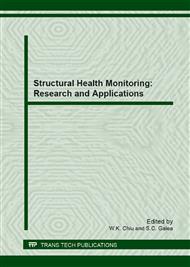[1]
N. Rajic, S. Weinberg, and D. Rowlands, "Low-cost Thermoelastic Stress Analysis," Materials Australia, vol. 40, 2007.
Google Scholar
[2]
A. Wong, "Making the Invisible Visible: Joining the Dots from Lord Kelvin to Fighter Jet Fatigue," in Proc. 28th Congress of the International Council of the Aeronautical Sciences (P. I. Grant, ed.), 2012.
Google Scholar
[3]
N. Rajic, S. C. Galea, and D. Rowlands, "Probing the Limits - New Opportunities in Thermoelastic Stress Analysis," in Proc. 28th Congress of the International Council of the Aeronautical Sciences (P. I. Grant, ed.), 2012.
Google Scholar
[4]
N. Rajic, D. Rowlands, and K. A. Tsoi, "An Australian Perspective on the Application of Infrared Thermography to the Inspection ofMilitary Aircraft," Proceedings of the 2nd International Symposium on NDT in Aerospace, Hamburg, Germany, 2010.[5] N. Harwood and W. M. Cummings, Thermoelastic Stress Analysis. Adam Hilger, Bristol, 1991.
Google Scholar
[6]
G. Pitarresi, L. D'Acquisto, and A. M. Siddiolo, "Thermoelastic Stress Analysis by Means of an Infrared Scanner and a Two-Dimensional Fast Fourier Transform Based Lock-in Technique," J. Strain Analysis, vol. 43, pp.493-506, 2008.
DOI: 10.1243/03093247jsa348
Google Scholar
[7]
J. Kostrzewa, W. H. Meyer, W. A. Terre, S. Laband, and G. W. Newsome, "Use of a Miniature Infrared COTS Sensor in Several Military Applications," in AeroSense - SPIE Digital Library, pp.141-149, 2002.
DOI: 10.1117/12.443529
Google Scholar
[8]
G. Pitarresi and E. A. Patterson, "A Review of the General Theory of Thermoelastic Stress Analysis," The Journal of Strain Analysis for Engineering Design, vol. 38, 2003.
DOI: 10.1243/03093240360713469
Google Scholar
[9]
A. K. Wong, J. G. Sparrow, and S. A. Dunn, "On the Revised Theory of the Thermoelastic Effect," J. Phys. Chem. Solids, vol. 49, pp.395-400, 1988.
DOI: 10.1016/0022-3697(88)90099-6
Google Scholar
[10]
L. Molent and B. Aktepe, "Review of Fatigue Monitoring of Agile Military Aircraft," Fatigue Fract. Eng. Mater. Struc., vol. 23, pp.767-785, (2000)
DOI: 10.1046/j.1460-2695.2000.00330.x
Google Scholar
[11]
L. Molent and J. Agius, "Agile Military Aircraft," in Encyclopedia of Structural Health Monitoring, John Wiley and Sons Limited, Chichester, U.K., 2009.
DOI: 10.1002/9780470061626.shm137
Google Scholar
[12]
A. K. Wong, M. Richmond, and T. G. Ryall, "Structural Assessment of the Orion P3 Wing Leading Edge by a State-of-the-Art Thermal Imaging System," in Proc. 6th Aust. Aero. Conf., pp.795-800, (1995)
Google Scholar
[13]
M. Zanganeh, R. A. Tomlinson, and J. R. Yates, "T-stress Determination Using Thermoelastic Stress Analysis," J. Strain Analysis, vol. 43, pp.529-537, 2008.
DOI: 10.1243/03093247jsa349
Google Scholar
[14]
P. Stanley andW. K. Chan, "The Determination of Stress Intensity Factors and Crack Tip Velocities from Thermoelastic Infrared Emmissions," in Proc. of International Conference on Fatigue of Engineering Materials and Structures, IMechE, pp.105-114, (1986)
Google Scholar
[15]
F. A.Diaz, E. A. Patterson, R. A. Tomlinson, and J. R.Yates, "Measuring Stress Intensity Factors During Fatigue Crack Growth Using Thermoelasticity," Fatigue Fract. Engng Mater. Struct., vol. 27, pp.571-583, 2004.
DOI: 10.1111/j.1460-2695.2004.00782.x
Google Scholar
[16]
J. M. Barton, T. R. Emery, S. Quinn, and P. R. Cunningham, "A Temperature Correction Methodology for Quantitative Thermoelastic Stress Analysis and Damage Assessment," Mea- surement Science and Technology, p.1627.
DOI: 10.1088/0957-0233/17/6/047
Google Scholar
[17]
G. Swanton and L. Robertson, "Developments with the F/A-18 FINAL Centre Barrel Test Program," in Proceedings of AIAC14 - The Fourteenth Australian International Aerospace Congress, Melbourne, Australia, 2011.
Google Scholar


